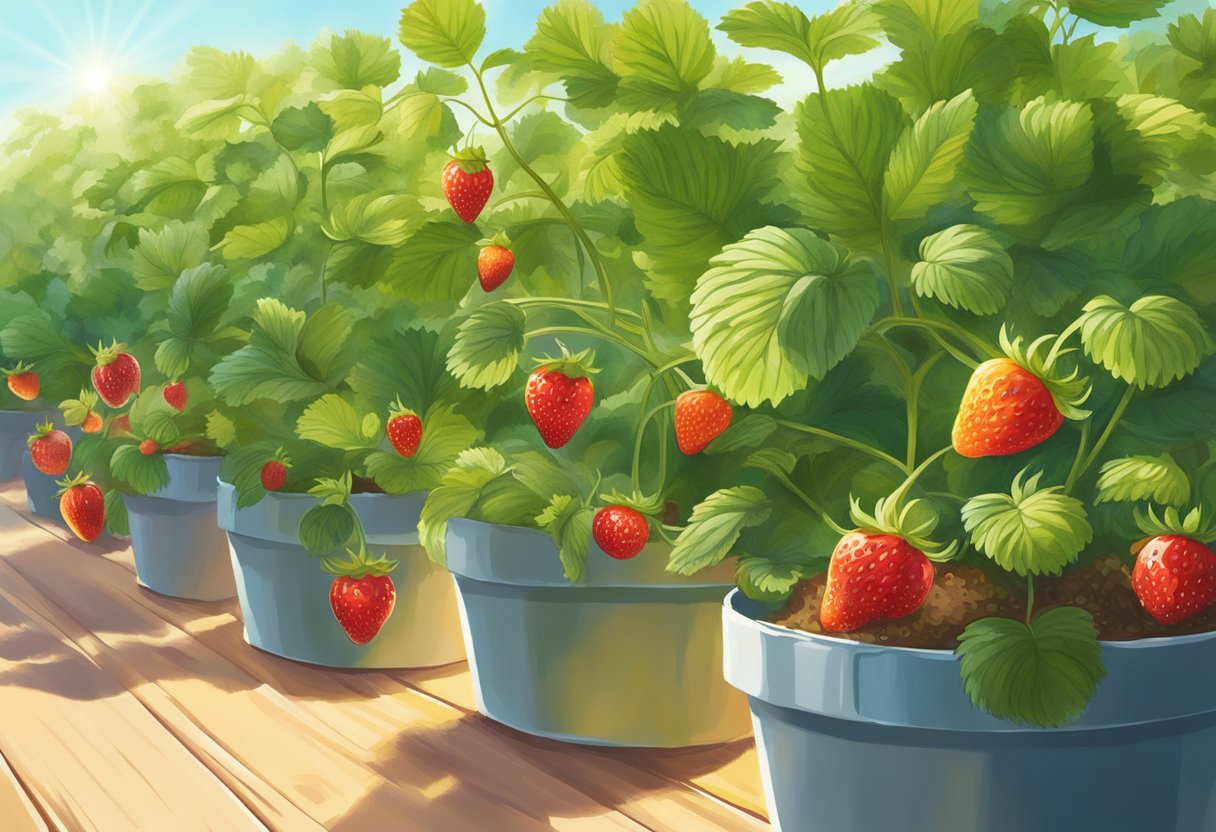Strawberry plants are among the most charming and widely cultivated fruit plants in home gardens, thanks in part to their relatively straightforward care requirements and the delightful reward of home-grown berries. As a gardener, I’ve found that one of the most crucial factors affecting the yield and health of strawberry plants is their exposure to sunlight. The amount of sun these plants receive directly correlates with their fruit production, plant vigor, and overall success.

For optimum growth and fruit production, strawberry plants require a minimum of six hours of direct sunlight per day.
In my experience, these plants thrive best when they receive full sun, which means at least six to eight hours of direct sunlight daily. When I plant strawberries, I choose a spot in my garden that receives ample sunshine throughout the day to ensure that they have the energy needed to produce sweet and juicy berries. Adequate sunlight not only aids in the development of the fruit, but it also helps to keep the plants healthy, reducing the risk of fungal diseases which can be prevalent in overly shady and moist conditions.
JUMP TO TOPIC
How to Grow Strawberries Successfully
In my experience, the success in growing strawberries hinges on selecting the appropriate varieties for your climate, understanding and meeting their soil and sunlight needs, and managing plant spacing wisely. Here’s how I ensure a bountiful harvest:
Choosing the Right Variety
Strawberries come in three types: june-bearing, everbearing, and day-neutral. June-bearing strawberries produce a large, concentrated crop in late spring to early summer, everbearing varieties give a smaller but continuous harvest from spring to fall, and day-neutral strawberries yield fruit throughout the growing season. I recommend choosing a variety that fits your gardening goals. If you’re interested in preserving, june-bearing might be your best bet, whereas everbearing and day-neutral types are excellent for fresh, continual harvests.
Understanding Soil and Sunlight Requirements
Planting and Space Management
I plant strawberries in the early spring as soon as the ground is workable. I make sure the crown is just above the soil line — too deep and they might rot, too high and the roots could dry out. For june-bearing strawberries, I space plants about 18 inches apart in rows 4 feet apart. Everbearing and day-neutral varieties can be spaced slightly closer at 12 inches since they are less vigorous. I remove most runners to prevent overcrowding and to focus the plant’s energy on fruit production.
Remember, whether you’re starting a new patch or maintaining an existing one, regular care is key. Keep the plants well-watered, especially during dry periods, and remove weeds that compete for nutrients and water. With these tips, you’re on the right path to enjoying sweet, home-grown strawberries.
Maintaining and Protecting Your Strawberry Plants
To ensure your strawberry plants thrive, it’s essential to focus on proper watering, fertilizing, and pest management. The success of your crop will depend on these crucial elements throughout the growing season.
Watering and Fertilizing Techniques
💥 Effective Watering
I ensure my strawberry plants receive enough water, which is particularly vital during dry spells. The goal is to keep the soil moist but never waterlogged. Here’s how I do it:
Fertilizing is just as crucial as watering. I incorporate organic matter into the soil before planting and use a balanced 10-10-10 fertilizer after the plants are established. However, I avoid over-fertilizing as it can lead to excessive leaf growth at the expense of fruit production.
Dealing with Pests and Diseases
Protecting strawberry plants from pests and diseases starts with proactive measures. I use mulch to keep the berries clean and deter slugs. Additionally, I make sure to plant in well-draining soil to prevent root rot and encourage strong growth. Here’s my approach:
| Action | Benefit | ||
|---|---|---|---|
| Pest Monitoring | I regularly check for bugs and gently remove them by hand. | ||
| Disease Prevention | To prevent powdery mildew, I ensure good air circulation by not overcrowding plants. |
Furthermore, if there is a warning for frost, I cover the plants overnight to protect them. Regular pruning of dead leaves and runners also helps in maintaining healthy crowns and an efficient root system, which is vital for plant resilience.
Harvesting and Enjoying Your Strawberries
When the berries are fully red and firm to the touch, they’re at peak ripeness for harvesting. I find this to be the best moment to enjoy your strawberries, as they offer the best balance of sugar and acidity.
Best Practices for Harvest Time
Harvest the strawberries in the cool of the morning when the fruit is still firm and immediately refrigerate them to preserve their freshness. When picking, gently twist the strawberry off the stem to avoid bruising. I make sure to:
- Check for ripeness daily. Strawberries ripen quickly and need to be picked every two to three days.
- Leave the caps on until use. This prolongs shelf life and reduces moisture loss.
- Avoid overripe berries. They can introduce mold and diseases to your bed if left unchecked.
Preserving and Using Strawberries
Strawberries can be enjoyed fresh or preserved. To maximize their shelf life, I store them in breathable containers in the refrigerator without washing—this prevents moisture from accelerating spoilage. For preserving, I often:
- Freeze strawberries on a baking sheet before transferring to an airtight container. This keeps them from sticking together.
- Make jams or jellies, which are perfect for enjoying the taste of fresh strawberries long after their season has passed.
- Prepare syrups or purees for flavoring drinks and desserts.
Proper storage and preservation allow me to enjoy the fruits of my gardening labor throughout the year, even when winter turns my strawberry bed dormant.












